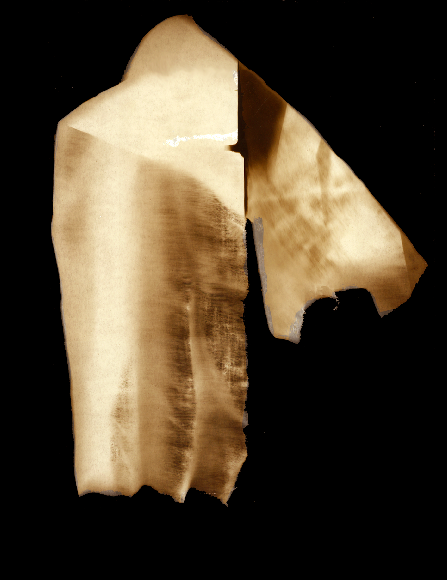Dreamt Horses IV
Copyright © Jim Doukas
With so much focus today on the digital image, commonly transmitted and viewed solely on computers and frequently dematerialized from any physical expression, it’s refreshing to discover an artist whose principal form centers on novel, idiosyncratic, and often idiomatic approaches to photography and printmaking.
Jim Doukas, whose latest exhibition Pairings is on show at the Joyce Gordon Gallery in Oakland, is just such an artist. Utilizing materials ranging from Polaroid film, handmade paper, and even chocolate-infused toners, Doukas harmoniously fuses a strong physicality with a studious reverence to ancient cultures, particularly Mesoamerican societies located throughout Mexico.
In parts of the work, for example, Doukas employs an overlap process that combines photographs with bark made by villagers located outside of Kathmandu, Nepal. In other instances, Doukas infuses his prints with a primal connection to its subject by toning them in a specially-concocted chocolate sulfide bath.
“The overlap process,” Doukas explains, “was a way of using two separate layers to create new meanings and new image strategies. The handmade papers under the large monochrome transparencies gave a feeling of depth to the pictures, and it also allowed unusual control over color texture.”
Chocolate, on the other hand, relates to the revered Mesoamerican drink that, for the Maya, went so far as to serve as a metaphor for life itself. “The notion was that drinking chocolate circumnavigated the inside of one’s body as blood did,” notes Doukas, “delivering life and energy.”
The current exhibition, while focusing on selections that appear in his book Ancient Mythologies: Recent Visitations (spanning the last 40 years of Doukas’s career), also includes work from 2009 called Branches which extends Doukas’s exploration of mythologies to include European histories. Included too are Doukas’s Polaroid Pairings, a tribute to the late Dr. Land, the inventor of the Polaroid system.
Individual pieces further Doukas’ conceptualization of the Mesoamerican experience. In Dreamt Horses VI and Dreamt Horses IV, for example, Doukas addresses the question of what the heads of horses might appear like to dreamers who had never seen an instance of the animal.
Created as a series of photogram prints by which the image is made without a camera by placing objects directly on a photo-sensitive surface before exposing it to light, Doukas was inspired by Aztec emperor Moctezuma’s obsession with divining the future.
In the myth, Moctezuma forces his advisors to enter a dreamlike state only to disturbingly foresee the destruction of the Aztec empire, led from the east by men-like gods riding on four-legged animals with unique heads (in a time when no horses naturally populated the continent).
Doukas’s images too are eerily dreamlike. And while a commemoration of this historic incident occurs yearly just north of Mexico City, Moctezuma’s advisors were less celebrated — all were unceremoniously executed.
Another theme that appears through multiple pieces is the mask, with several nude female figures wearing or holding elaborate ornaments constructed principally of wood. To Doukas, the mask signifies our own life force, the energy that animates our physical being consisting of bones, flesh, and hair.
“In a similar way,” Doukas explains, “a mask is constructed of wood and paint and string and sits on the floor as a lifeless object until the model picks it up and puts energy into it. Literally, it too, comes to life.”
The female form is not without its own significance, as A.D. Coleman notes in the introduction to Ancient Mythologies: Recent Visitations, “The recurrence of the female form as central motif serves as a binding force. The encroachment of Christianity during the centuries of European colonialism consistently marginalized the feminine. Doukas restores this generative force to its primacy in the symbolic universe.”
Taken together, Pairings not only condenses Doukas’ rich, decades-long investigations but also succeeds in offering a sumptuous adventure in both classical and hand-made photography. The exhibition, consisting of photographs, photograms, polaroids, and paintings, is on display until December 28, 2009.
The Joyce Gordon Gallery is a commercial fine art gallery located in the downtown district of Oakland California. It exhibits art that reflects the social and cultural diversity of the Bay Area and international artists. The aim of the gallery is to respect the creative pursuits of the individual and seeks to make such work accessible to a broad audience.
Plan Your Visit
Joyce Gordon Gallery
406 14th St, Oakland, CA 94612
www.joycegordongallery.com
510-465-8928
Wednesday – Friday 12 to 7 pm
Saturday – Sunday 1 to 4 pm

